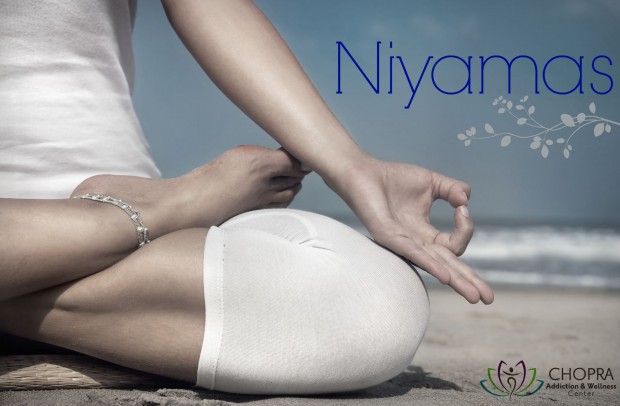The Second Limb of Yoga: Niyamas

The Eight Limbs of Yoga are the eight important steps of a yoga practice that help us live fuller, happier lives. The Eight Limbs were created as universal guidelines by Maharishi Patanjali, who is considered the “father of Yoga”. Patanjali compiled the 195 Yoga Sutras (or primary Yoga talking points) that serve as the foundation of Yoga. Today, we’ll learn about the Niyamas, which are the second of the Eight Limbs of Yoga. The Niyamas are personal practices, rituals and daily activities for wellbeing and spiritual growth. (You can learn more about each of The Eight Limbs of Yoga here).
There are five Niyamas that help us shape our personal behavior.

The first Niyama is Soucha, which is the practice of cleanliness. Soucha not only refers to the cleanliness in personal hygiene, but it also addresses the cleanliness of our internal environment (our bodies) and our living environment.
For example, one way to practice Soucha is by committing to the wellbeing of our environment and taking active measures to care for the Earth. Actively engaging in the internal practice of Soucha includes eating nourishing meals that keep the body running efficiently, and replacing toxic thoughts with those that are more positive, creative and productive. We can also keep our bodies and minds clean by avoiding drugs and alcohol, which only prompt us to lose control of our actions and the choices we make when we live drug and alcohol-free lives.
The second Niyama is called Santosha meaning contentment. Santosha refers to surrendering the control of our lives in the present moment, and going with the flow. When we live our lives this way, we’re much more receptive to opportunities and experiences that present themselves when we keep an open mind. The result of practicing Santosha is experiencing increased love and joy in our own lives. When we’re happy and carefree, we can be of even greater service to others, and positively impact more lives around us.
When we’re not practicing Santosha, we tend to be discontent and hold onto resentment towards others. For example, as is the case for many individuals in recovery, it can be difficult to connect with something positive in life- even if it’s only one person, experience or circumstance. But by practicing Santosha and surrendering to all circumstances-good and bad- that have brought us to any given moment, the result is often a deeper sense of gratitude for the respective paths we’re on.
The next Niyama, Tapas, focuses on self-discipline. The word Tapas in Sanskrit for fire. When we live a life that is simple and organized, aligned with the rhythms of the universe, we allow the light, or fire, of Universal Consciousness into our lives. Some ways we can practice Tapas include waking early in the day, taking time to meditate in the morning and evening, eating well, connecting joyfully with others, and getting plenty of exercise and rest.
It’s important to show up and be responsible for our own well-being. One way we can cultivate Tapas is through Satsang, which is the practice of connecting with individuals who seek to understand the Higher Self. Satsang is especially important for those who walk the path of sobriety. Those who practice Satsang contribute to a community of like-minded individuals, who assist us with creating positive routines that support our wellbeing.
The fourth Niyama is Svadhyaya, or sacred study. When we read literature that enhances our spiritual growth, we shift from looking to our external environment for answers, to turning within and trusting our own divine wisdom. As we reflect on our inner selves, we also begin to understand that everything we need in life can be found by connecting with who we really are, which is Pure Consciousness. Whether you need an answer to one of life’s challenges, or guidance on your personal path, the answers can always be found within the wisdom of your own being— and practicing Svadhyaya can help you discover how to tune in to this innate ability.
The texts that have proven to be most beneficial for practicing Svadhyaya for those in recovery are: Freedom from Addiction: The Chopra Center Method for Overcoming Destructive Habits by Dr. Deepak Chopra and Dr. David Simon and The Seven Spiritual Laws of Yoga: A Practical Guide to Healing Body, Mind and Spirit by Dr. Deepak Chopra.
The fifth Niyama is called Ishwara-Pranidhana. Ishwara Pranidhana refers to surrendering to the Divine, or a Higher Power. When we have awareness and faith in a Divine Presence greater than ourselves, we begin to see the same presence in everything and everyone around us. This gives us a deeper understanding of the principle that we are all one, or, as is often said: “the divine in me recognizes the divine in you”.
Spending time in nature allows us to practice Ishwara-Pranidhana, by helping us recognize that all things have the same prana, or life energy within them, that is expressed uniquely.

Ishwara-Pranidhana also refers to surrendering to the wisdom of uncertainty, relinquishing our attachment to the past, and trusting that the uncertainty of the present moment holds the key to personal transformation. By focusing on these personal manifestations of Universal Consciousness, we’re also able to let go of what no longer serves us to make room for new experiences and lessons for our growth.
Through yoga asana and meditation sessions, healthy meals, and holistic counseling, the Chopra Addiction & Wellness Center team helps our guests and their families become more familiar with the Niyamas and integrate these simple guidelines into a new, happier way of life.
